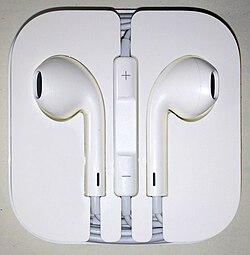APPLE HEADPHONES:
Apple Inc. has produced and sold headphones since 2001, available for standalone purchase and bundled with iPhone (until 2020) and iPod (until 2022) products. Apple’s current product line consists of EarPods (wired earbuds available with a 3.5mm headphone or Lightning connector or USB-C), AirPods and AirPods Pro (wireless Bluetooth earbuds), and AirPods Max (wireless Bluetooth over-ear headphones). apple headphones
Apple’s original earbuds shipped with the original iPod, released on October 23, 2001. apple headphones They were never given a formal name and were referred to variously as “iPod headphones”[1] and “the iPod’s earbud-style headphones”.[2] They were bundled with two pairs of foam covers.[3] The second generation added a plastic slider to allow the user to limit the gap between the wires. The third generation were redesigned with a slightly longer strain relief, a slightly smaller speaker grill, and the left/right marking being moved from the outside to the inside.Apple’s original earbuds shipped with the original iPod, released on October 23, 2001. They were apple headphones

The iPhone Stereo Headset was introduced in 2007 and was bundled with the original iPhone and iPhone 3G, and featured a control capsule in-line with the left earbud’s wire with a microphone and a single button, actuated by squeezing the unit, which can be programmed to control calls, presentations, music and video playback, launch Siri, or take pictures with the Camera application. There was also a version without the microphone that was more rare. apple headphones There have been many reports of moisture problems with the remote/mic.[4] apple headphones
EarPods[9] were introduced on September 12, 2012 and feature a redesign with no silicone tips, less visible metal, and a plastic outer shell. They first shipped with the iPhone 5 and feature a remote control and microphone. They also shipped with the iPod Touch (5th generation) and iPod Nano (7th generation) without a remote and microphone. EarPods are also individually sold with a carrying case, while the version bundled with the iPod Touch (5th generation), iPod Touch (6th generation) and iPod Nano (7th generation) only have basic biodegradable packaging, due to their lack of a remote and mic. A microphone icon was added on the previously unmarked back side of the control capsule on EarPods with a microphone.[10] They are compatible with iPhones from the iPhone 3GS to iPhone 6S, the iPod Touch (2nd generation) and onwards, and all models of the iPad, iPad mini, and iPad Pro, except the third and fourth generation iPad Pro. They require iPhone OS 2.2 and onwards for iOS devices but are not compatible with the original iPhone, iPhone 3G, or iPod Touch (1st generation) due to sound problems. They are also compatible with most Android devices and computers. apple headphones
EarPods[9] were introduced on September 12, 2012 and feature a redesign with no silicone tips, less visible metal, and a plastic outer shell. They first shipped with the iPhone 5 and feature a remote control and microphone. They also shipped with the iPod Touch (5th generation) and iPod Nano (7th generation) without a remote and microphone. EarPods are also individually sold with a carrying case, while the version bundled with the iPod Touch (5th generation), iPod Touch (6th generation) and iPod Nano (7th generation) only have basic biodegradable packaging, due to their lack of a remote and mic. A microphone icon was added on the previously unmarked back side of the control capsule on EarPods with a microphone.[10] They are compatible with iPhones from the iPhone 3GS to iPhone 6S, the iPod Touch (2nd generation) and onwards, and all models of the iPad, iPad mini, and iPad Pro, except the third and fourth generation iPad Pro. They require iPhone OS 2.2 and onwards for iOS devices but are not compatible with the original iPhone, iPhone 3G, or iPod Touch (1st generation) due to sound problems. They are also compatible with most Android devices and computers. apple headphones

A second iteration, EarPods with Lightning Connector, was introduced in 2016 along with the iPhone 7 and replaced the 3.5mm headphone jack with a Lighting connector. They work with all devices that have a Lightning port (except iPad mini (1st generation) and iPod touch (5th generation)) and support iOS 10 or later. The previous EarPods were rebranded as “EarPods with 3.5mm Headphone Plug”. apple headphones Since early 2017, both products now lack a carrying case, instead being sold in recyclable cardboard packaging.[11][12]A second iteration, EarPods with Lightning Connector, was introduced in 2016 along with the iPhone 7 and replaced the 3.5mm headphone jack with a Lighting connector. They work with all devices that have a Lightning port (except iPad mini (1st generation) and iPod touch (5th generation)) and support iOS 10 or later. The previous EarPods were rebranded as “EarPods with 3.5mm Headphone Plug”. Since early 2017, both products now lack a carrying case, instead being sold in recyclable cardboard packaging.[11][12] apple headphones
Lightning to 3.5mm dongle:
iPhone models from the iPhone 7 to the iPhone X also shipped with a Lightning-to-3.5mm headphone jack adapter, enabling customers to connect 3.5mm headphones to a Lightning port. Thanks to an iOS update (iOS 10.3), it is backwards compatible, meaning it can be used with any previous device with a Lightning port (from iPhone 5 onwards). It is no longer included as of the iPhone XS and iPhone XR, but remains available for purchase from Apple and third-party retailers.[citation needed]iPhone models from the iPhone 7 to the iPhone X also shipped with a Lightning-to-3.5mm headphone jack adapter, enabling customers to connect 3.5mm headphones to a Lightning port. apple headphones Thanks to an iOS update (iOS 10.3), it is backwards compatible, meaning it can be used with any previous device with a Lightning port (from iPhone 5 onwards). It is no longer included as of the iPhone XS and iPhone XR, but remains available for purchase from Apple and third-party retailers.[citation needed] apple headphones

iPhone Bluetooth Headset:
The iPhone Bluetooth Headset was introduced in 2007 priced at $129 and later reduced to $99. It was discontinued in 2009. It was designed for phone calls only and could not be used for listening to music. The integration included showing an icon for the headset and its battery level. It was bundled with a “Travel Cable” that charged it and a 30-pin iPhone simultaneously, and a docking station called the iPhone Dual Dock that could charge it and an original iPhone was also available.[5][19]The iPhone Bluetooth Headset was introduced in 2007 priced at $129 and later reduced to $99. It was discontinued in 2009. It was designed for phone calls only and could not be used for listening to music. The integration included showing an icon for the headset and its battery level. It was bundled with a “Travel Cable” that charged it and a 30-pin iPhone simultaneously, and a docking station called the iPhone Dual Dock that could charge it and an original iPhone was also available.[5][19]The iPhone Bluetooth Headset was introduced in 2007 priced at $129 and later reduced to $99. It was discontinued in 2009. It was designed for phone calls only and could not be used for listening to music. The integration included showing an icon for the headset and its battery level. It was bundled with a “Travel Cable” that charged it and a 30-pin iPhone simultaneously, and a docking station called the iPhone Dual Dock that could charge it and an original iPhone was also available.[5][19] apple headphones
AirPods were announced alongside the iPhone 7 and were released on December 16, 2016.[20][21] They are wireless earbud-style headphones with microphones, dual accelerometers, IR sensors used to pause music if they are not in the user’s ears, and motion touch sensors that are used to activate controls. They are advertised as having a battery life of five hours, and come with a charging case that gives them a total of 24 hours of battery life. The original case is charged by Lightning, and in 2019 a second case was introduced with Qi charging. AirPods are compatible with iPhones, iPads, Apple Watches, Macs, the 6th generation iPod Touch, and the 7th generation iPod Nano, but automatic pairing with an iCloud account requires macOS Sierra, iOS 10, and watchOS. They are also compatible with devices on other platforms that support Bluetooth, but it limits the AirPods’ functionality.[22][23] apple headphones
AirPods were announced alongside the iPhone 7 and were released on December 16, 2016.[20][21] They are wireless earbud-style headphones with microphones, dual accelerometers, IR sensors used to pause music if they are not in the user’s ears, and motion touch sensors that are used to activate controls. They are advertised as having a battery life of five hours, and come with a charging case that gives them a total of 24 hours of battery life. The original case is charged by Lightning, and in 2019 a second case was introduced with Qi charging. AirPods are compatible with iPhones, iPads, Apple Watches, Macs, the 6th generation iPod Touch, and the 7th generation iPod Nano, but automatic pairing with an iCloud account requires macOS Sierra, iOS 10, and watchOS. They are also compatible with devices on other platforms that support Bluetooth, but it limits the AirPods’ functionality.[22][23] apple headphones

On September 9, 2024, following the announcement of the fourth-generation AirPods, and all-new advanced hearing aid features for AirPods Pro 2 and the updated AirPods Max with USB-C port,[24] all the devices of the AirPods product line have been transitioned from the proprietary Lightning port to the universal USB-C port, making both the second-generation AirPods, third-generation AirPods and the original AirPods Max with Lightning port discontinued.[25]On September 9, 2024, following the announcement of the fourth-generation AirPods, and all-new advanced hearing aid features for AirPods Pro 2 and the updated AirPods Max with USB-C port,[24] all the devices of the AirPods product line have been transitioned from the apple headphones proprietary Lightning port to the universal USB-C port, making both the second-generation AirPods, third-generation AirPods and the original AirPods Max with Lightning port discontinued.[25] apple headphones
On September 9, 2024, following the announcement of the fourth-generation AirPods, and all-new advanced hearing aid features for AirPods Pro 2 and the updated AirPods Max with USB-C port,[24] all the devices of the AirPods product line have been transitioned from the proprietary Lightning port to the universal USB-C port, making both the second-generation AirPods, third-generation AirPods and the original AirPods Max with Lightning port apple headphones
discontinued.[25]

